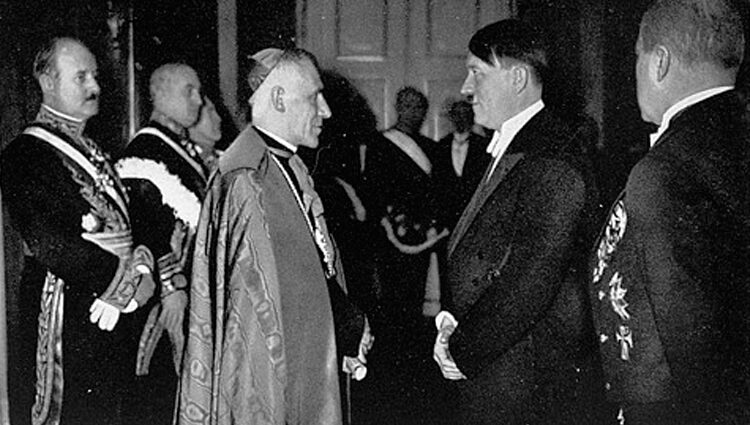Many people can wonder – why did Nazi regime prosecute the Catholic church with such a vigor and passion? Aren’t they both Conservatives who should rather stand together in their struggle against Communism and Modernism? Didn’t Catholics support the rise of Nazi power in Germany? But in reality the relationships between the Catholic church and the Nazi movement were very complicated, and sometimes it was up to the level of hostility; to a big extent it was due to the conflicting values, goals and ideals, and this history goes much earlier than even the birth of the ideology of National Socialism, or Nazism.
The origins of the conflict between the German government and the Catholic church can be seen ever since the unification of Germany. Two trends were going hand by hand back then – from one side, there was a patriotic desire of many Germans, including the Chancellor Bismarck, to limit any foreign influence over the newly formed German Empire, to have it only for Germans and by Germans which was a common idea in many countries back then; from another side, the Pope and the Holy See, being defeated by the Kingdom of Italy in 1870, were seeking for the ways to increase their influence in the Catholic world, and among those means the Pope wanted to control the appointments of bishops, education, books and press in Catholic countries and regions.
While Prussia, the major country of the new German Empire, was predominantly Protestant, some other states, notably Bavaria, were the strong Catholic outposts in Germany. This made Chancellor Bismarck to start in 1871 a so-called “Kulturkampf”, a widescale campaign to limit the influence of the Catholic church. While eventually it gave only minor victories to Germany, it had strengthen the view of Catholics as not too patriotic imperial citizens, and it had deep consequences several decades later.
The National Socialist Party of Germany, ever since its creation, didn’t have too favorable view neither of Christianity nor particularly of the Catholic church. The Nazis saw Christianity as too peaceful and too Jewish in its core and, following the popular views from the German Empire, Nazis also saw Catholics as prone for the foreign influence from the Holy See. Altogether it gave the image of the German Catholics as neither too German, nor too patriotic, and this was the base of the serious conflict of ideals. It’s also important to understand that to a big extent Nazi movement and nationalist agenda of those times in Germany was influenced by the history and mythology from the Pagan times, by those virtues and ideals that were opposite to the Catholic ones in many ways. Many of Nazi senior officials, like head of ideology Alfred Rosenberg or the chief of the Hitler’s chancellery Martin Bormann were ardent Pagans, and didn’t even try to hide their strong dislike of Christianity in general, and of the Catholicism in particular.
On the political front it wasn’t any easier – while on the Left the major competitor of the National Socialist Party were the Communists, on the Right big part of resistance came from the political Catholicism – Center Party and Bavarian People’s Party – both of whom stood on conservative Catholic positions, and represented mostly the ideas of Christian democracy. Democracy and Catholicism together, both of elements were disliked by the Nazis, but together, especially with rather good election results, they started to be seen as the threat to the Nazi Party since the late 1920’s.
But even when the Nazi Party had become the major one in Germany, and Adolf Hitler was appointed a Reich Chancellor on January 30, 1933, it wasn’t an easy task to attack the Catholic church for them – due to lots of previous political struggle, many prominent Catholics had become their temporary allies, and even Vice-Chancellor in the first Hitler’s Cabinet, Franz von Papen, who was mostly responsible for the whole daily work of the whole Cabinet, was a Catholic himself. There were also big groups among the elites of Germany who were Catholics too and who supported the Nazis in hope to get rid of the Communists and to strengthen the country – politicians, industrialists, officers, professors. To attack those elites openly could mean a real civil war in Germany, and the Nazi government had come with another plan.
The “Kirchenkampf” started – a long campaign to undermine the influence of the Catholic church and to make its members join the Nazi movement instead. Step by step, starting already in 1933, Catholic parties and youth groups were dissolved, church councils and church finances were put under the supervision of the German officials. In 1937 the Pope issued “Mit brennender Sorge” encyclical, calling out the Nazi regime as ungodly and anti-Christian, which was brought to Germany as contraband and spread in the churches. It intensified the conflict – the circulation of the encyclical was made illegal, arrests of priests started, Catholic churches and printing offices were closed upon finding those illegal materials there, by 1939 most of the previous liberties used by the Catholic church were revoked – even priests were now drafted to German army among all the other people.
To sum it all up, the conflict between the Nazi Party and the Catholic church was inevitable due to opposing ideals and values, and by the active role of Political Catholicism in Germany before National Socialists had got the power there. And, as the mist peaceful party in this conflict, Catholic church didn’t have a chance to win in this confrontation.
